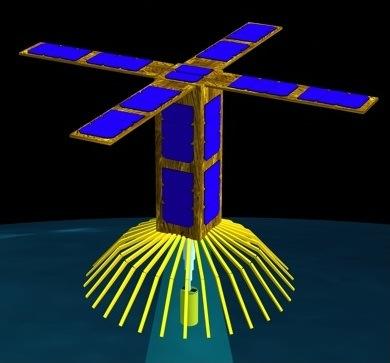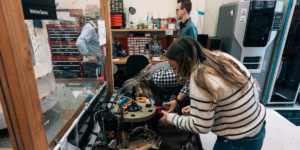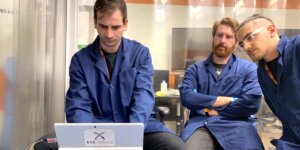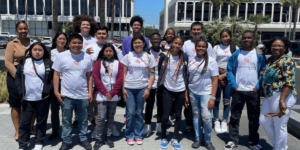
Depiction of Aeneas satellite in orbit
The University of Southern California Information Sciences Institute, in conjunction with the USC Space Engineering Research Center (SERC), today announced development of a dedicated USC satellite mission, Aeneas.
Supported by several Government agencies including the Operationally Responsive Space Office and the Air Force Research Lab at Kirtland AFB, the Aeneas mission is helping to validate a Department of Homeland Security technology demonstration program to track cargo containers worldwide.According to SERC Associate Director David Barnhart, the Aeneas will be a “3U Cubesat,” a nanosatellite comprised of three interconnected cubic units, each with 10 cm sides. It will contain new payload technology for operation and maturation in radio frequency, computer and distributed operation applications for Cubesats.
The program is the first of several funded satellite and spacecraft development efforts at USC that will provide students direct hands-on experience in satellite design assembly and integration.
Through SERC and ISI, and the prime industry collaborator iControl Incorporated, a team of student-professional integrators will enhance a baseline Cubesat bus, integrate newly developed primary and secondary payloads, and write/load and checkout flight software for integration and test development.
The satellite will be environmentally tested at Wyle Labs in El Segundo for qualification and acceptance prior to shipment to the launch vehicle integrator.
SERC students are also constructing a dedicated USC ground station to operate the satellite after launch and while it is in orbit. The station will have a 12-foot remote-controlled parabolic dish, as well as a server with custom-made communications and database software.
The USC Viterbi School of Engineering, the home of ISI, is working with other universities to become part of a global Cubesat ground station network for distributed command and control operations to enable worldwide access at fractions of the cost of traditional command and control systems.
Through the Viterbi School’s Astronautical Engineering Division’s focus on space technology and spacecraft design and ISI’s focus on prototype systems and information assembly processing and system delivery, the SERC is attacking multiple problems in spacecraft architecture and technology development in revolutionary ways.
SERC is a direct result of discussions with NASA and DoD managers to address increasing skill levels and experience base of graduating engineers for direct transition to industry and government aerospace jobs.
Students have gained invaluable real-world experience through the industry-team partnership and under tight scheduling and budgeting constraints, much like most aerospace programs today.

Each student in the program is emerging with exposure to key space industry skill sets, including systems engineering, manufacturing, integration and test of complex systems, design and operation of ground control stations and software, quality control and the overall programmatic flow of satellite design. Because each of the satellites subsystems are highly interdependent and all critical to mission success, it is a truly multi-disciplinary project where students must apply several different elements from their curriculums simultaneously.
The Aeneas project is one of a handful of new efforts through SERC. USC’s Astronautics degree program, which is one of three accredited astronautics curriculums in the US, offers a variety of hands-on training activities in an approach similar to that of many other universities: involving students in actual hardware implementation. The SERC process however, aims to pioneer a deeper cultural training shift to create a techno-social setting that embeds students in a regimen that is found in most industry and government labs today.
SERC is following a “teaching hospital” approach, where the professional engineers mentor the student “residents” on all technical aspects of satellite development while also immersing them in a programs-intensive environment that must deliver a working satellite system.
“SERC is pushing an alternative to the positive but short-term benefits of grand challenges and prize competitions in the academic environment to affect a true cultural and social shift in how aerospace engineering is imbued in students of today,” says Barnhart. “Leveraging students’ inherent net-connectivity to affect more efficient processes, and encouraging them to ask ‘why’ when they go to industry and government will help infuse innovative change within the aerospace industry.”
Cubesats, which were first developed by Stanford University and Cal Poly San Luis Obisbo, have emerged as truly innovative toolsets that the next generation of aerospace engineers are using to help drive this change. “Our goal is to cut down the current 5-10 year cycle for advancement in aerospace to more of a ‘Google’ time frame, where innovation occurs within months,” adds Barnhart. “We believe the only way that will happen is by dramatically challenging the teaching model, and USC is doing just that.”
SERC will deliver the Aeneas satellite to the launch coordinator next summer, for launch in early 2011 with other Cubesats.
Published on February 11th, 2010
Last updated on August 5th, 2021












